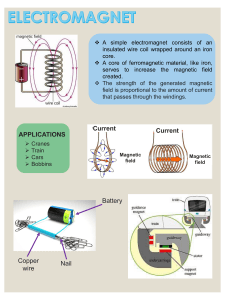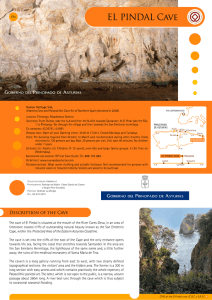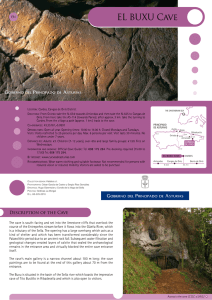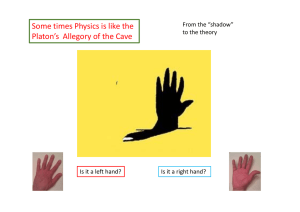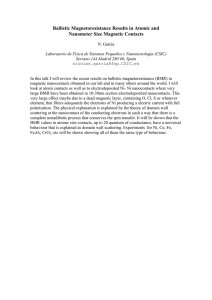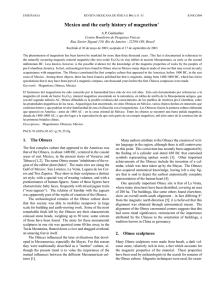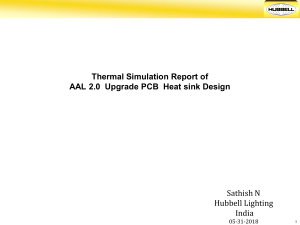Dowsing for Cave Location: Royal Forest of Dean Symposium
Anuncio
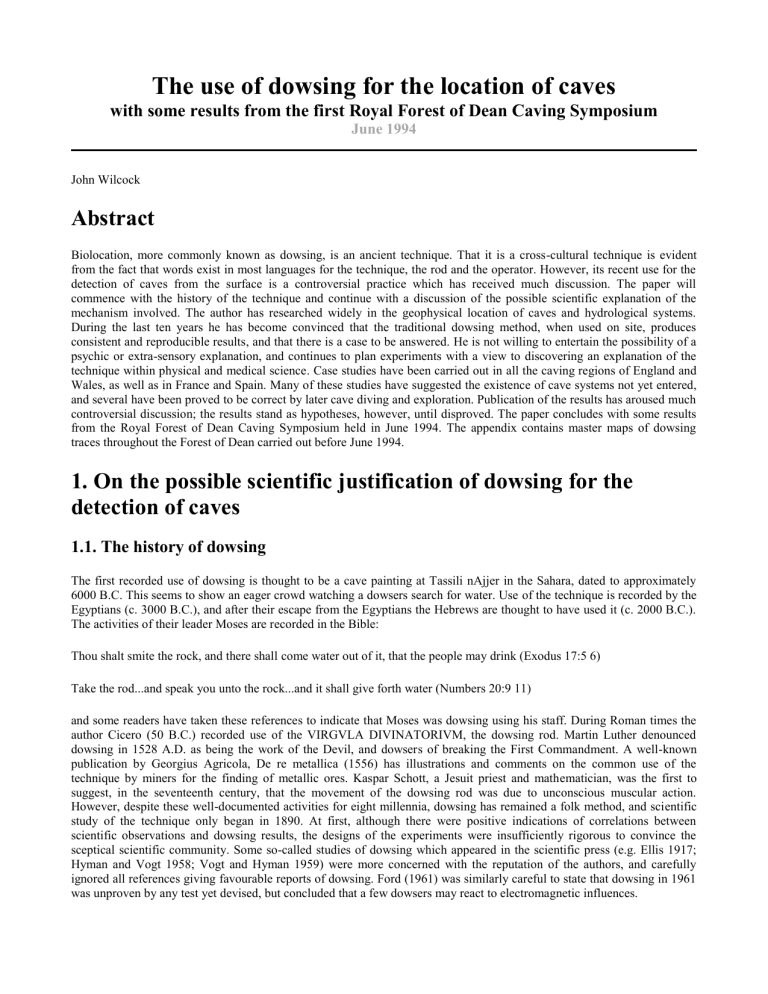
The use of dowsing for the location of caves with some results from the first Royal Forest of Dean Caving Symposium June 1994 John Wilcock Abstract Biolocation, more commonly known as dowsing, is an ancient technique. That it is a cross-cultural technique is evident from the fact that words exist in most languages for the technique, the rod and the operator. However, its recent use for the detection of caves from the surface is a controversial practice which has received much discussion. The paper will commence with the history of the technique and continue with a discussion of the possible scientific explanation of the mechanism involved. The author has researched widely in the geophysical location of caves and hydrological systems. During the last ten years he has become convinced that the traditional dowsing method, when used on site, produces consistent and reproducible results, and that there is a case to be answered. He is not willing to entertain the possibility of a psychic or extra-sensory explanation, and continues to plan experiments with a view to discovering an explanation of the technique within physical and medical science. Case studies have been carried out in all the caving regions of England and Wales, as well as in France and Spain. Many of these studies have suggested the existence of cave systems not yet entered, and several have been proved to be correct by later cave diving and exploration. Publication of the results has aroused much controversial discussion; the results stand as hypotheses, however, until disproved. The paper concludes with some results from the Royal Forest of Dean Caving Symposium held in June 1994. The appendix contains master maps of dowsing traces throughout the Forest of Dean carried out before June 1994. 1. On the possible scientific justification of dowsing for the detection of caves 1.1. The history of dowsing The first recorded use of dowsing is thought to be a cave painting at Tassili nAjjer in the Sahara, dated to approximately 6000 B.C. This seems to show an eager crowd watching a dowsers search for water. Use of the technique is recorded by the Egyptians (c. 3000 B.C.), and after their escape from the Egyptians the Hebrews are thought to have used it (c. 2000 B.C.). The activities of their leader Moses are recorded in the Bible: Thou shalt smite the rock, and there shall come water out of it, that the people may drink (Exodus 17:5 6) Take the rod...and speak you unto the rock...and it shall give forth water (Numbers 20:9 11) and some readers have taken these references to indicate that Moses was dowsing using his staff. During Roman times the author Cicero (50 B.C.) recorded use of the VIRGVLA DIVINATORIVM, the dowsing rod. Martin Luther denounced dowsing in 1528 A.D. as being the work of the Devil, and dowsers of breaking the First Commandment. A well-known publication by Georgius Agricola, De re metallica (1556) has illustrations and comments on the common use of the technique by miners for the finding of metallic ores. Kaspar Schott, a Jesuit priest and mathematician, was the first to suggest, in the seventeenth century, that the movement of the dowsing rod was due to unconscious muscular action. However, despite these well-documented activities for eight millennia, dowsing has remained a folk method, and scientific study of the technique only began in 1890. At first, although there were positive indications of correlations between scientific observations and dowsing results, the designs of the experiments were insufficiently rigorous to convince the sceptical scientific community. Some so-called studies of dowsing which appeared in the scientific press (e.g. Ellis 1917; Hyman and Vogt 1958; Vogt and Hyman 1959) were more concerned with the reputation of the authors, and carefully ignored all references giving favourable reports of dowsing. Ford (1961) was similarly careful to state that dowsing in 1961 was unproven by any test yet devised, but concluded that a few dowsers may react to electromagnetic influences. A further wait until 1971 was necessary before the first properly-conducted double-blind study was carried out by a sceptic (Chadwick and Jensen 1971), with control experiments and statistically valid results. The design of rigorous experiments continues, for example the Greensites Project (1990) and The Dowsing Welly Experiment (1993, reported by Wilcock (1994)). 1.2. Scope of the study This study will be restricted to those dowsing results which could be due to a physical effect on site. Phenomena deliberately ruled out in the study are: the activities of people who claim that it is not even necessary to visit the site, but that maps can be dowsed by a pendulum at home; dowsing for ley lines; and medical dowsing (radiesthesia). 1.3. Who uses dowsers? The long list of users of dowsing may be surprising to some readers: Engineering Companies (e.g. the Bio-Physical Method (BPM) was used in 1971 in the former USSR to detect water filtering through a dam (Bird 1979)) Water Companies (a pair of dowsing rods is carried inside the doors of Water Board vans) Mining Companies (e.g. documented use for finding ore and petroleum in the USSR (Bakirov 1973)) Laundries (for water supply) Breweries (for water supply) Building Contractors (to locate unknown service pipes on building sites) Farmers (for water supply) Government Departments Police (location of buried items and, it is rumoured, bodies) Armed Forces (dowsing used by the British Army since Colonial times); dowsing appeared in USSR army manuals in 1930 for the finding of water in remote areas; dowsing used by the First and Third US Marine Divisions in Vietnam, 1967, as a simple, low-cost method for locating Vietcong tunnels, which were used for communication, storage depots, supply network, command posts, training centres, hospitals and sally ports for over twenty years (Bossart 1968 in the Project Poorboy Annual Progress Report; Bird 1979, Chapter 11)). A large number of general descriptions of dowsing methods have been published in books designed for popular reading (e.g. Graves 1976; 1986; Bird 1979; Naylor 1980). 1.4. What is detected? Location of the following features by dowsers is well-documented (Tromp 1949 and many other studies): Flowing water Springs, and lines of springs Wells Circulating groundwater Service pipes and trenches (not just water pipes, but electricity cables and gas pipes, so the trench may be what is being detected) Buried foundations Roots of big trees Geological faults, some of which will have ore deposits Caves with flowing water Large dry caves It is undeniable that dowsing has been profitably used for the detection of new wells for water supply (e.g. Mullins et al. 1894). 1.5. Possible physical fields It has been suggested that dowsers are detecting a physical field on site. If this is true then what could it be? The following types of fields have been suggested as possible candidates: Gravitational Magnetic Electric Electromagnetic Radioactive Seismic (the stress field around fractures, fissures and faults) Geothermal Geochemical Of these, the magnetic, electric and electromagnetic fields are probably the most likely candidates. However, for this to be accepted, a physical explanation must be provided for the generation of the signals by the features, and for the detection mechanism within the human body. 1.6. What do dowsers experience? Dowsers claim that they experience a variety of phenomena, such as tingling like an electric shock , a chilly sensation, shivering, trembling, or an unpleasant sensation in the stomach. In attempts to determine the source of this apparent shock to the central nervous system, instruments have been attached to subjects to measure muscular contractions, changes in heart potential and changes in electrical skin potential. Involuntary muscular contractions have been observed, and convulsive spasms, sometimes violent. Electrocardiogram responses have been seen which exhibit a 20mV step change when the dowsing rods are observed to move (Tromp 1949), and changes in skin potential have also been measured. In experiments when artificial fields have been produced, a delay of between 5s and 10s is observed between production of a field change and the electrocardiogram response. This suggests processing via the brain and central nervous system, rather than direct nerve stimulation. Furthermore, the rods are observed to move after the field change. 1.7. Why do the rods move? The movement of the dowsing rods is clearly initiated by muscular action. This is observed to be sometimes violent enough to peel bark from a Y-stick, and to scratch hands painfully. Novice dowsers who were former sceptics were unaware of this involuntary muscular action, and claimed they were trying to stop the rods moving. The material of the rods does not matter, since they are just acting as a mechanical amplifier of small muscle movements. Some experiments have indicated that blindfolding stops a dowsing reaction: sceptics have said this indicates that sight was being used to supply alternative information, such as depressions in the ground, geological features, etc., but an alternative explanation could be that the array of cells at the back of the eye is a detector for more than just light, or the optic nerve may be part of the feedback loop to the central nervous system. Parameter changes measured by electrocardiogram or skin potentiometer occur before the rods move, showing that it is not the movement of the rods that initiates the effect. Some dowsers claim that the faster they walk, the stronger is the dowsing reaction, which might suggest that some form of electromagnetic induction is in operation. It has been suggested that a magnetic field detecting sixth sense would have been lost through misuse during evolution. However, genetic changes take much longer than a few thousand years to take effect. We still have the fight or flight syndrome which causes our hearts to pound when we perceive ourselves to be threatened, even though in modern life we are not going to punch our opponent or to run away, and the net result of this is the modern curse of heart attacks. Also our spinal columns have not really adapted to the change from quadripedal to bipedal gait, resulting in the modern defects of bad backs and slipped discs. 1.8. Sensitivity Washing hands in hot water appears to cause dowsing sensitivity to increase, even for those who claim not to be able to dowse. The following measurements of electrical resistance between left and right palms may indicate a correlation between electrical resistance of the human body and dowsing ability. The two columns in the table below are for dowsing-sensitive persons and non-sensitive persons (Tromp 1949): Degree of wetness of palms Degree of wetness of palms Sensitive Persons, Wet hands 10 Quickly-dried hands 22 Towelled hands 38 Hot air-dried hands 50 Non-sensitive Persons, 50 250 400 500 (3000?) Table 1. Electrical resistance left to right palms Thus sensitive persons have lower resistances at all times than non-sensitive persons, by a factor of about ten, but it is just possible that non-sensitive persons with wet hands may approach operating conditions of sensitive persons, and under these conditions may be able to dowse. 1.9. Published studies Experimenters have found that it is difficult to design experiments which have controls, are double blind, and have statistical significance. By double blind is meant that the experimenters must themselves not know the correct answer, so that there is no possibility of passing on information unconsciously to the operators. Preferably the experimenters should be sceptics, so that positive results will carry more weight. In 1933 De Vita placed electroscopes over underground streams, and found that they discharged more rapidly than control electroscopes placed over normal ground of the same soil type and rock type. Jemma confirmed de Vita's results in the following year, and also found that dowsers are affected by the ionisation of the air. This so called fine-weather field is affected by the altitude and position of the sun, and is to do with atmospheric electricity. There are also indications that dowsers are affected by electrical storms. Maby and Franklin ,both physicists (1939), found that dowsers reacted to electromagnetic waves. The frequency may well be important, however, since I have conducted a series of experiments under overhead electricity pylons, and have found no reaction for a 50Hz electromagnetic field, and I have also visited transmitters and found no reaction for radio and radar transmissions at higher frequencies. Tromp (1949) proposed a possible mechanism where the human body passing at speed through a field will increase in capacity as it approaches the conductor (stream of water), and skin potential will decrease. If this is the mechanism, it will be affected by the initial skin resistance, the relative conductivities of the soil and the underground stream, the speed of movement and the conductivity of the atmosphere. Tromp pointed out that carrier pigeons became disoriented near radio and radar transmitters, and in the high potential gradients caused by whirling snow. He also discussed a number of animals which appear to have navigational ability, such as carrier pigeons, salmon, eels, dolphins, whales and bees (see also Kirschvink (1981)). Other interesting matters pointed out by Tromp are that magnetite is found in the beak and wing feathers of carrier pigeons, and Papuan humans can often navigate in dense jungle. In 1952 a team of electrical engineers tested the famous dowser Henry Gross, and found that his skin potential changed by up to 200mV over subterranean water, compared with a change of 10mV for non-dowsers. Rocard, a French physicist (1964) reported that dowsers react to changes in the earth’'s magnetic field caused by underground water, and claimed that electric currents of 50mA/m2 in water and magnetic field gradients of 1mG/m were detectable by dowsers. He also claimed to have found that a high skin conductivity is desirable for good dowsing results. Barrett and Besterman (1968) carried out field studies for finding water, using a number of independent experiments with two or more dowsers, and compared the results with those suggested by consultant engineers and geologists. They found the dowsers got twice as much water as the engineers, while the geologists got hardly any . They concluded that the movement of the dowsing rods is due to unconscious muscular action, the tension of the grip being converted to sudden neuromuscular spasms when the operator is in the presence of water. Harvalik (1970), a physicist, found that the dowser reacts to changing magnetic fields produced by electric ground currents with frequency in the range 1 500Hz, but not to static magnetic fields. Using magnetometers he deduced that the dowser reacts to as little as 10-9G change. There was some indication that dowsing ability was enhanced by drinking water, perhaps indicating that conductivity in the region of the kidneys is important. It is impossible to exclude the earth’'s magnetic field from the brain or any other part of the body, and there is therefore no reason why the development of a field-detecting ability should be ruled out. Harvalik conducted elaborate experiments with metal shielding of the human body, and a torchlike instrument to concentrate and direct an artificial magnetic field in an attempt to locate the positions of possible sensors. When the operator was carried horizontally on a stretcher, the reaction occurred when the solar plexus was over the feature. When the metal shield was between the navel and the breast bone the signal was not detected, indicating a detector site slightly below the solar plexus, perhaps the adrenal gland in the kidney region (which contains magnetite, as reported by Kirschvink (1981)). Shielding of the head indicated a second possible detector site at the base of the brain, perhaps the pineal gland. It has also been found that human bones from the region of the sphenoid/ethmoid sinus complex contain magnetite, and it is suggested that these deposits are concerned with magnetic field detection; the sinus complex approximating to the region previously deduced from orientation experiments to be the site of a magnetoreceptor (Baker 1981; Baker et al. 1983). Other points mentioned by Harvalik are that two detectors will be necessary to detect a field gradient, and the detection mechanism could be based on nuclear magnetic resonance (calculations indicate that the earth's magnetic field would give rise to precession at about 2000Hz, and a field gradient of 1mG/m would give a beat frequency of about 1Hz which could be detectable). A good summary of Harvalik's work is also given by Bird (1979). The work of Chadwick and Jensen (1971) appears to be the first documented experiment carried out under double blind conditions which was relevant to the dowsing problem. Chadwick, the experimenter, was a sceptic, and did not know the correct answers. 150 subjects were tested, mostly novice dowsers. A path was chosen leading through a park, with no known features. Subjects were asked to place small wooden blocks where they felt they were getting a reaction or field . The positions of the blocks were noted after each run, and removed before the next run. When all the subjects had been tested, a conventional magnetometer survey was carried out along the path. The correlations between the subjects and the magnetometry were found to be statistically significant at the .05 level. There was therefore some evidence of correlation between magnetic gradient changes and dowsing reactions. The conclusions were that there are sufficient statistically significant results to warrant further investigations. Williamson (1979) reported on the use of the biophysical method (BPM) in Russia. Of wells suggested by BPM operators, only 8% were dry, while of those suggested by geophysical methods 13% were dry. Randi (1979) conducted a test with four dowsers in Italy, using three buried pipes with running water. As stated by Chamberlin (1980) the test had several deficiencies. No meaningful statistical evaluation was possible, and the test contributed little knowledge to the scientific community. Presti and Pettigrew (1980) reported the occurrence of magnetic material in the neck muscles of homing pigeons, and have suggested that this is coupled to muscle receptors to form an effective magnetic detector. Hansen (1982) gives an especially good summary of experimental research into the techniques of dowsing. Killip (1984) reviewed the possibilities for detecting geophysical anomalies at building sites by dowsing. He carried out a systematic survey using rectangular traverse lines, and claimed that a standardised technique can locate many types of buried features on a proposed construction site, including brick culverts with underground streams, service pipes and pipe trenches, and buried foundations. Killip was careful to say that there should be further corroboration by excavation, boring, seismic, resistivity, magnetometric and gravimetric instruments, but pointed out that many of the features could not be detected by these methods within a reasonable budget. Since dowsing is cheap, he therefore states that the lack of a scientific explanation should not be held as justification for non-use, since reliable and consistent readings can be obtained by methodical working. A similarly successful detection of old church foundations has been demonstrated by Bailey et al. (1988). Baig (1985) reported dowsing undertaken in India. The water vein detected by dowsing was then surveyed by earth resistivity meter, when water-bearing strata were detected. It was deduced that the dowsing method could produce waterbearing rocks more quickly than could conventional methods. Mogila (1986) reported a field study at the Monastery of the Caves, Kiev, where conventional sub-surface radar had failed to locate secret passageways. Of 130 sites indicated by dowsers, 73 (56%) corresponded with existing passages, previously known to the curators but not to the dowsers. At a further 29 dowsed sites (22%), previously unknown to the curators, test drillings revealed cavities. This gave a total success rate of 78%. Williamson (1987) suggests magnetic anomalies as the basis of dowsing. This may be given greater credence by the work of Hess et al. (1987), who have shown that magnetic stimulation of the human brain from coils placed over the human scalp causes twitches of the hand muscles, which can be greatly enhanced by concurrent voluntary contraction. The Greensites Project (France 1990; Herbert 1990) has aimed to compare the results of various methods for detecting caves from the surface, including geophysical, botanical and dowsing techniques. Electromagnetic traversing (resistivity, magnetometry) gave the best results at unknown cave locations, but there is good correlation for several dowsers. An experiment over Pant Mawr involved several independent dowsers, and was carried out using a pegged-out grid over passages which had been accurately radiolocated. Nobody who dowsed the grid was present on the day the surveying was done. The dowsers participated on different days and did not exchange information between themselves, nor were they given any indication of the other results obtained. There was some correlation between dowsers, and with the known cave position, and one dowser produced a plan which appeared to be an enlargement of a small part of the cave, at the correct angle (France 1991a). The conclusion on this was the jury is still out (France 1991b). Vilchko (1993) reported his experiments with migratory birds in the BBC4 Science Now programme on 24.8.93. Magnetite is found in birds near the brain, in the flight feathers and in the beak. His experimental birds when released flew out of the cage in the migratory direction. He has also found that birds use white, green or blue light to magnetise the retina of the eye, while red light disorientates them. This magnetic orientation therefore uses magnetite, the retina of the eye and light, and a similar mechanism could clearly also apply to humans. Wilcock (1994) has reported the results of The Dowsing Welly Experiment held to detect any correlation between earthing of the dowser and lack of dowsing reaction. While the experiment suffered from some technical design problems, it was concluded that there was no connection between earthing and lack of dowsing reaction. 1.10. Case studies of feature location by dowsing Wade (1961) was one of the earliest cavers to use dowsing for speleological purposes. He attempted cave location on Greenhow Hill, assisting diggers in the search for an entry to Mongo Gill Caverns, and found Strans Gill Pot in Wharfedale. He also undertook experiments at Black Keld (in an attempt to detect the Mossdale Caverns to Black Keld route from the Black Keld end), at Gill House Pot, on Fountains Fell and in Chapel-le-Dale. Bossart (1968) has reported the regular use of dowsing by U.S. troops to detect Vietcong tunnels in Vietnam in 1967. A detailed plan and section of the tunnels used for the experiments is given by Bird (1979, Chapter 11). Ogil’vy carried out a search for a lost underground drainage system at the Ostankinsky Palace in Moscow, and dowsing predictions for its location were proved accurate by digging (Bird 1979, 240). Pluzhnikov undertook a search for medieval escape tunnels between the citadel and two monasteries in Serpukhov (Bird 1979, 242 244). The tunnels were located by dowsing in less than eight hours, and proved to be 2m wide, several km in length, and to pass under the River Nara in two places. Dore used dowsing to locate Scott Hollow Cave in southern West Virginia (Anderson, Internet personal communication 1993). The dowsing was used to determine where to begin digging with a backhoe (mechanical excavator), and entry was gained to about 20km of passages. DiBlasi (Internet personal communication 1993) has reported an experiment in 1987 to locate buried foundations in which geophysical surveys were compared with dowsing results. The first instrument used was a Martin-Clark resistivity meter; and 20 person hours was needed for gridding and inserting probe arrays, plus 1.5 person hours for entering the data into a surface modelling program on a computer. Next an EM-38 conductivity meter was used; taking 12 person hours for survey and 1.5 person hours to enter data; this instrument is just placed on the ground, and the results were nearly identical to those of the resistivity meter. Finally two independent dowsers who had not seen the previous geophysical results took half an hour to outline the foundations with flags (total 1 person hour) and to obtain identical results. Dowsing also located a pit which the other two methods did not locate. The site was excavated and the results of all three methods were confirmed, but obviously dowsing was much more cost-effective. In a further experiment with a proton gradiometer, dowsing proved considerably more accurate than the gradiometer in locating buried structures (this is not surprising, as the proton gradiometer does not excel at finding wall and road foundations). Dowsing has also been used with great accuracy to locate graves of many periods, the results being proved by excavation. My own work in limestone regions has led to the following suggestions about the courses of new caves, later proved by cave diving and exploration: the East Kingsdale Master Cave route (followed before it was proved by diving) the new diving route north east from West Kingsdale towards Yordas Cave the diving route at Alum Pot east north east towards the route between Washfold Pot and Footnaw's Hole the Dub Cote/Brackenbottom water supply/Douk Gill/Brants Gill route, which must be the main drain for the Fountains Fell water the direction of the Gingling Hole extensions SYMBOL 183 \f "Symbol" \s 10 \h a predicted route for the Malham Tarn Sink water via Malham Cove then south west and south to Aire Head Springs (not yet entered, but a dye test from Malham Cove proved positive, as reported in Descent 109) detection of some passages in Slaughter Stream Cave, before their subsequent exploration, the prediction of a Coldwell Swallet/Redhouse Swallet connection, and a Redhouse Swallet/Slaughter Stream Cave connection under Chapel Hill and Bicknor Street (the last two await exploration) the route of Swildons Hole beyond the final sump, dowsed three years before it was entered at White Pit to yield about 100m of passages to a depth of 35m, lying over the active route of Swildons Hole on its way to Wookey Hole dowsing at Greendown Farm with Dave (Tusker) Morrison, followed by Hymac digging on the same day to reveal Clay Holes. This has been dug to some depth, and the predicted dowsing route is south-west towards Wigmore Swallet in the Western Massif of the Picos de Europa, a passage was predicted from a new pot 8/11, near the top camp of the OUCC 1992 Expedition at Ario, to a previously unknown exit at the Mohandi alp. After I left, this was explored and completely surveyed from 8/11 to the unknown exit, then named Pozu Mohandi (26/11) 1.11. Conclusions The following opinions are the reasoned conclusions of this paper: The dowser is endowed with a subconscious cognitive faculty which results in unconscious muscular reaction, accompanied by a nervous sensation The mechanism for detection may be magnetic or electric in nature, and high skin conductivity seems to be a contributing factor The detector sites in the human body may be magnetite dispersed in tissue with nerves running through it, or the retinas of the eyes (needing light to activate them), the pineal gland and/or the adrenal glands. The movement of the rods is caused by amplification of small involuntary muscular contractions resulting from stimulation of the central nervous system, perhaps by magnetic stimulation of the brain or spinal column using two detectors Water divining survives today because its practical utility does not place too great a strain on pragmatism. Dowsing results will ultimately be validated by their accuracy and practical value rather than theories and opinions What is now required is the development of a general theory which will permit scientists to incorporate the biolocation mechanism into scientific knowledge. 2. Results from the Royal Forest of Dean Caving Symposium held in June 1994 The organisers of the walks to Slade Valley and Bearse(Maurice Febry) and Coldwell/Symonds Yat/The Dropper (Dave Parker) must be thanked for putting up with the dowsing training trips, and for letting me in particular walk in front without comment, except when something had been found by dowsing reaction. 2.1 Slade Valley and Bearse, 11th June 1994 The results are plotted on Figure 1. The area had never before been visited by me, I was not shown the map of the route, and before the end I must confess I had a profound sense of disorientation. The results were drawn on the map after our return. From the car park at the track crossing within the wood at Bearse Common (572058), I was asked to walk along the track in both directions, SE towards the main road, and NW into the forest. Nothing was found between the main road and the car park, but a positive indication was obtained heading SW across the track, just to the W of the car park. We walked down the track SW. A reaction was obtained crossing the track in a southerly direction passing under a barn (571057), and then heading out SW into a flat field. This was followed back N to a depression and sink (I was told later that this was Barn Sink). Proceeding WSW down Slade Valley, a quarry was inspected north of the track, but nothing was detected there. Continuing down the track, a strong reaction was obtained crossing NE-SW (this was later found to go to Slade Valley Rising (W side) at 566055, but was not followed at the time). A branch track was taken, crossing the stream and proceeding uphill into the wood SSW. Here two reactions were obtained: one ran from the eastern boundary fence of the wood due W to Dark Hill Cave. Another ran WSW downhill through very dense woodland, and was followed to the stream. Returning to the main track and proceeding WSW, the above mentioned strong reaction was confirmed to Slade Valley Rising (W side), as were two others, the second being Slade Valley Flood Rising, and the third having a pump blockhouse. At Slade Bottom a track was taken SE and then E through Slade Wood. The first reaction crossed ENE-WSW and was later revealed to be a continuation of the second reaction near Dark Hill Cave. A reaction to Slade Wood Resurgence from the ENE, traced to the wood boundary, is probably a continuation of the feeder from Barn Sink. Three further reactions were obtained along the track E through Slade Wood before the main road. The first comes from the SW to a small rising, the second crosses NE-SW but has no visible feature, and the third, wide reaction runs from the road N of Bearse Farm to the SW and is probably heading eventually for Clanna via Little Hoggins. Proceeding E into the Forestry Commission plantation along a track E and then N, a reaction was obtained running E-W. This is probably from an as yet unidentified sink near the eastern boundary of the plantation, and no doubt joins the Clanna drainage. Proceeding N, no further reactions were obtained until a series of depressions just across a fence. A strong reaction was obtained from Rutters Hole due W to the main road. Proceeding back towards the cars, and N into the Bearse Common plantation, the strong reaction was picked up at Bearse Pot, and then followed back through dense undergrowth to the track crossing W of the cars, to complete the circular walk. It appears, therefore, that a continuous feeder has been detected from Rutters Hole, via Bearse Pot and Barn Sink to Slade Wood Resurgence. Two parallel routes, probably old risings, run W, one emerging at Dark Hill Cave. Three systems from the NE emerge at risings in Slade Valley. One system from the SW emerges at a small rising in Slade Wood. Finally, a system from the eastern boundary of the Forestry Commission plantation circles Bearse Farm and probably heads for Clanna. These results are a fair indication of what can be achieved in an afternoon's walk in an unknown area by dowsing. 2.2. Coldwell, Symonds Yat and The Dropper, 12th June 1994 This walk began at the English Bicknor Sports Club, and initial dowsing training was carried out along Redhouse Lane, on the reaction running from Bicknor Court Swallet to Redhouse Swallet (see Figure 2). A further reaction was obtained running NNW-SSE across the T-junction due E of Bicknor Court. Along the Coldwell Walks, the first reaction was obtained at Ship Rock, where a small cave was visited. Coldwell Swallet has a strong reaction running SE, and probably joins the reaction running from the NW to Redhouse Swallet. In the woods south of Symonds Yat, Symonds Yat Swallet and a series of sinks flowing WNW and NW join the Slaughter Resurgence feeder. At The Dropper a reaction indicated that this sink flows due W and probably joins the feeder which runs from Cross Joints Swallet to Slaughter Resurgence. The dowsing party returned Hillersland and Blackthorns Farm, passing over two of the three parallel passages of Slaughter Stream Cave, and also visiting the Chapel Hill reaction for the proposed route from Redhouse Swallet to Slaughter Stream Cave under Chapel Hill and Bicknor Street. References Agricola, Georgius 1556. De re metallica, Book 12. English translation 1912, Mining Magazine, London. Also translated by Hoover, H.C. and Hoover, L.H. 1950, Dover Publications, New York. Baig, M.Y.A. 1985. Water-divining and geophysical exploration for groundwater. Assoc. Hydrol. India 4th annual convention and seminar on hydrology, Hissar, 14.6.85, III-4 III-5. Bailey, R.N., Cambridge, E. and Briggs, D.H. 1988. Dowsing and church archaeology. Intercept Ltd, Wimborne. Baker, R.R. 1981. Human navigation and the sixth sense. Hodder & Stoughton, London. Baker, R.R., Mather, J.G. and Kennaugh, J.H. 1983. Magnetic bones in human sinuses. Nature 301, 6.1.83, 78 80. Bakirov, A. 1973. BPM lessens drilling costs and makes prospecting more efficient. Prague conference. Barrett, W.F. and Besterman, T. 1926 and 1968. The divining-rod, an experimental and psychological investigation. Methuen and Co., London (1926) and University Books, New York (1968) Bird, C. 1979. The Divining Hand. E.P. Dutton, New York. Bossart, R.K. 1968. The utility of dowsing as a means of detecting Vietcong tunnels. In Gardinier, R.J. and Clauser, J.K. (eds) Project Poorboy Annual Progress Report, Proj. NR-348-018, Contract N00014-67-C-0349, Office of Naval Research, HRB-Singer Inc. State College, Pennsylvania Chadwick, D.G. and Jensen, L. 1971. The detection of magnetic fields caused by groundwater and the correlation of such fields with water dowsing. Utah Water Research Laboratory Report PRWG 78-1, January 1971, U.S. Geological Survey, Water Resources Division. Chamberlin, H. 1980. Dowsing tests deficient? The Skeptical Enquirer the Zetetic 4(4), 76 77. Ellis, A.J. 1917. The divining rod a history of water witching. U.S. Geol. Survey Water-Supply Paper 416, Washington, 59pp. Ford, T.D. 1961. Underground water, geology and water-divining. Trans. Cave Research Group of G.B. 6(1), 3 17 France, S. 1990. The Greensites Project. South Wales Caving Club Newsletter 106, 29 31. France, S. 1991a. Detecting caves. William Pengelly Cave Studies Trust Limited, Newsletter 61, August 1991, 19 27 France, S. 1991b. Jury still out in dowsing case. SWCC Newsletter 109, Summer 1991. Graves, T. 1976. Dowsing: Techniques and applications. Turnstone Books, London. Graves, T. 1986. The diviner's handbook. The Aquarian Press, Wellingborough. Hansen, G.P. 1982. Dowsing: a review of experimental research. J. Soc. Psychical Research 51(792), 343 367. Harvalik, Z.V. 1970. A biophysical magnetometer-gradiometer. Journal of the Virginia Academy of Science 21(2), 59 60. Herbert, M. 1990. Greensites: Dowsing. South Wales Caving Club Newsletter 108, 16 17. Hess, C.W., Mills, K.R. and Murray, N.M.F. 1987. Responses in small hand muscles from magnetic stimulation of the human brain. J. Physiol. 388, 397 419. Hyman, R. and Vogt, E.Z. 1958. Some facts and theories on water-witching in the USA. Geotimes 2(9), 6 7 and 15. Killip, I. 1984. Detecting geophysical anomalies at construction sites by dowsing. Land and Minerals Surveying 2(12), 633 644 Kirschvink, J.L. 1981. Journal of Experimental Biology 92, 333 335. Luther, Martin 1528. Decem praecepta. Wittenberg. Maby, J.C. and Franklin, T.B. 1939. The physics of the divining rod, being an account of an experimental investigation of water and mineral divining. George Bell, London. Mogila, I. 1986. Dowsing in the Soviet Union. Soviet dowsers reveal long sought for legendary and hidden underground passageways at Russia's famous Monastery of the Caves near Kiev. Psi Research, 5 (1 2) March/June 1986, 34 38 Mullins, J. and sons 1894. The divining rod; its history, truthfulness and practicability. Colerne, Box, Wiltshire. Naylor, P. 1980. Discovering dowsing and divining. Shire Publications Ltd, Princes Risborough. Presti, D. and Pettigrew, J.D. 1980. Ferromagnetic coupling to muscle as a basis for geomagnetic field sensitivity in animals. Nature 285, 99 101. Randi, J. 1979. A controlled test of dowsing abilities. The Skeptical Enquirer the Zetetic 4(1), 16 20. Rocard, Y. 1964. Le signal du sourcier. Dunod, Paris. Tromp, S.W. 1949. Psychical physics: A scientific analysis of dowsing, radiesthesia and kindred divining phenomena. Elsevier Publishing Company, New York. Vogt, E.Z. and Hyman, R. 1959. Water witching USA. University of Chicago Press, Chicago, 248pp. Wade, C. 1961. Divining. Trans. of the Northern Cavern and Mine Research Society 1, 12 22. Wilcock, J.D. 1994. An experiment to investigate the supposed connection between the biolocation reaction and electrical insulation from the ground: The dowsing welly experiment. Cave Radio & Electronics Group Journal 15, 10 11 Williamson, T. 1979. Dowsing achieves new credence. New Scientist 81, 8.2.79, 371 373. Williamson, T. 1987. A sense of direction for dowsers? New Scientist 19.3.87, 40 43. John Wilcock, 22 Kingsley Close, STAFFORD ST17 9BT Appendix A: Forest of Dean Master Maps The appended maps are dowsing results obtained over wide areas of the Forest of Dean before 1992. Figure A1. This map is chiefly concerned with the Slaughter Stream Cave, and the destination of its waters. Points of note are: Hoarthorns Wood Swallet and Kiln Hole predicted connection to the neighbourhood of Wet Sink Coldwell Swallet predicted connection to Redhouse Swallet Bicknor Court Swallet predicted connection to Redhouse Swallet Redhouse Swallet predicted connection to neighbourhood of Chunnel Passage, passing under Chapel Hill and Bicknor Street Slaughter Resurgence is thought to be leakage through the roof of a flooded passage which goes beneath the River Wye. The reaction is detectable on the opposite bank near The Biblins. It is then predicted to dramatically change direction to the SSE to join other drainage from the W side of the Forest of Dean, and to eventually go beneath the River Severn near Lydney Figure A2. This map covers the central section of the western side of the Forest of Dean coalfield, and part of the course of the River Wye. The work during the symposium in the Slade Valley and Bearse area on 11th June 1994 is not shown. Points of note are: Two former meanders of the River Wye at Newland and Lower Meend. These have been visited to see if former sinks could be detected, but nothing has been found Continuation of the southwesterly predicted course for water passing under the River Severn, with sinks at Trowgreen and Noxon The continuation to the SW to the region of Lydney is not shown. Here it is predicted to join a similar deep feeder from the eastern side of the Forest of Dean coalfield running SSW, and probably drainage also from the trough of the syncline under the coal. The eastern deep feeder picks up drainage from sinks at Westbury Brook, Trow Ditch at Greenbottom, Cinderford Brook at Ruspidge Valley, Howbeech Trough, and Blackpool Brook at Blakeney Walk. After the feeders join near Lydney, they are predicted to continue SE under the River Severn. Figure A3. The map covers the southern part of the course of the River Wye, showing part of the Otter Hole System (described on Figure A4), and also a series of predicted caverns along the Tidenham Chase Syncline. Points of note are two separate groups of feeders (shaded differently): Ban-y-Gor feeder joins a complex series of feeders from Parson's Allotment and Poor's Allotment (Madcats) Dennel Hill via Boughspring These feeders are predicted to join, to pass under Dayhouse Quarry (which is flooded) and to feed SSW under the River Severn, where the (first) Severn Bridge boreholes found artesian fresh water and a cavity. Figure A4. This map covers the area to the west and south-west of Chepstow. Three main systems are covered, Otter Hole, Well Head/Grondra/Lavant Well, and the Severn Tunnel Great Spring System. Points of note are: Apart from the well-known Rookery Sink and Rogerstone Grange Sink feeders to Otter Hole, predicted routes are shown from Croes Bleddyn Swallet, Itton North Swallet, Itton South Sink, and a sink in the stream bed of the Mounton Brook 300m NW of Pandy Mill at 492945 Complex connections are predicted between a sink in Mounton Brook at Pandy Mill (494944) and Well Head Resurgence, and further sinks at 495942 and 499938 together with The Grondra to Lavant Well Section of the Severn Tunnel Great Spring feeders south of Caerwent to Whirley Holes Resurgence (now dry, but which was reported to have vast volumes of clear water before the Severn Tunnel Great Spring was tapped) and the Nedern Brook Sink (which was capped with a concrete invert as it was thought to be a source for the Great Spring). The System is further described on Figure A5 Figure A5. The map covers the Penhow, Rogiet and Caldicot regions, and concerns two systems, White Brook to St Bride's Mill, and the Severn Tunnel Great Spring System. Points of note are: Predicted route from White Brook Sink, via Penhow to St Bride’'s Mill Predicted routes from Wentwood Reservoir Sink, Llanvair Discoed (two sinks) and Cas Troggy to deep feeder S to Rogiet, with branch to the south of Caerwent to Whirley Holes Resurgence (see Figure A4) and the Nedern Brook. The feeder to Rogiet is predicted to swing ENE under Caldicot. From the Nedern Brook the route is predicted to be SE to Portskewett, Sudbrook and the Severn Tunnel Great Spring, and then under the River Severn Figure captions Figure 1. Dowsing tests at Slade Valley and Bearse, 11th June 1994. Figure 2. Dowsing tests at Redhouse Swallet, Bicknor Court, Coldwell Walks (Ship Rock and Coldwell Swallet), Symonds Yat Swallet and other swallets to Slaughter Resurgence, and The Dropper, 12th June 1994. Figure A1. Master map for the northern region of the Forest of Dean. Figure A2. Master map for the central eastern region of the Forest of Dean. Figure A3. Master Map for the southern part of the River Wye. Figure A4. Master Map for the Otter Hole, Mounton Brook, Lavant and Caerwent regions. Figure A5. Master Map for the Penhow, Rogiet and Caldicot regions.
